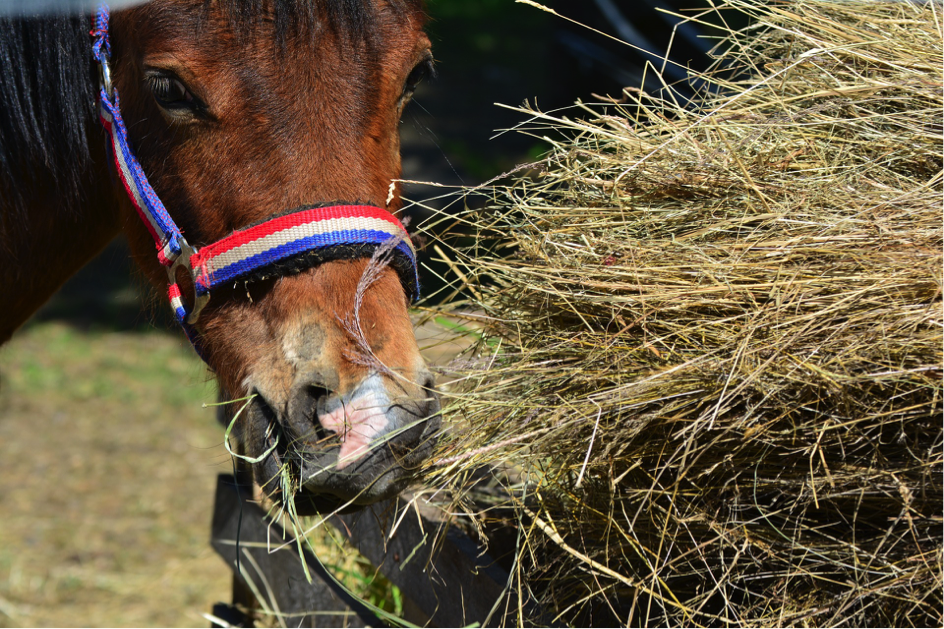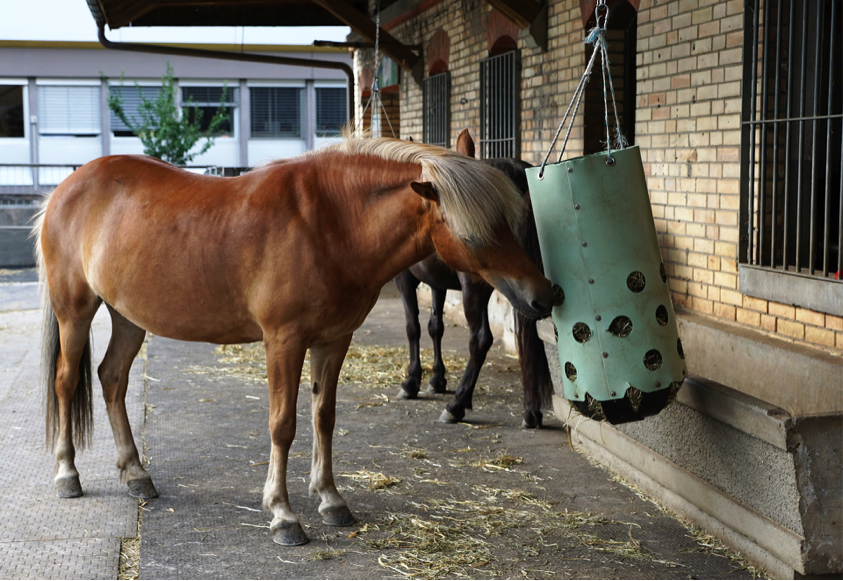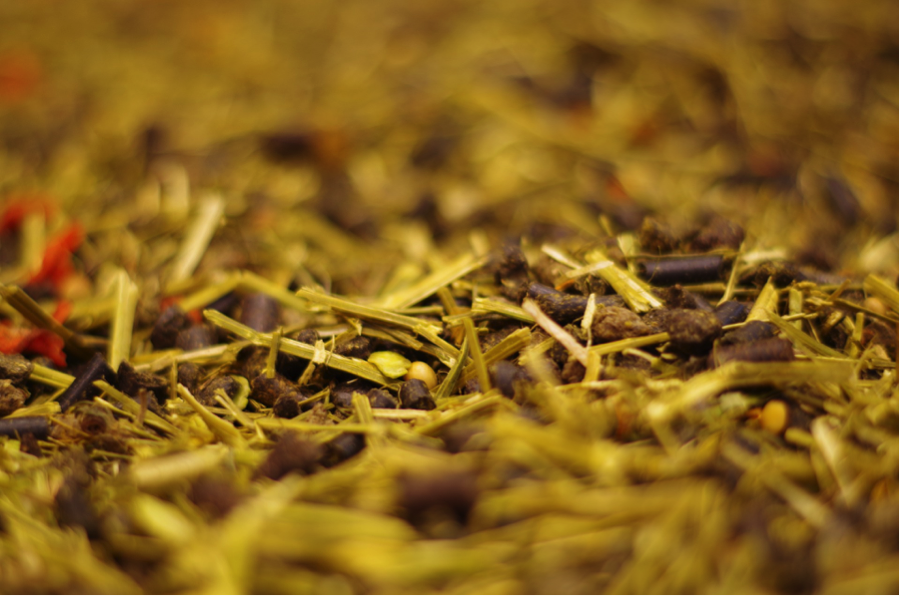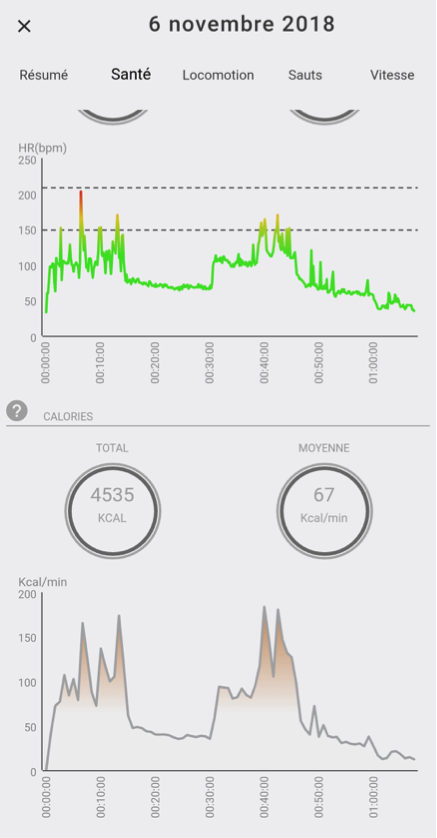Thursday, November 15, 2018
Just like care, feeding is essential to the horse's well-beingand health and performance. A poorly adapted diet can cause colic or other digestive disorders. It can also be a daily source of discomfort and stress. In this article, we tackle the sensitive subject of diet.

The horse is a non-ruminant monogastric herbivore. It spends between 15 to 19 hours a day feeding in the wild. It feeds in the form of multiple small mealsday and night. Unlike humans, they are not adapted to eating large quantities of food. Its digestive tract is adapted to its natural feeding habits. Its large intestine is highly developed, while its stomach and small intestine are small. So it's vital to understand the main characteristics of your horse's digestion. It's also important to understand their consequences, so you can better adapt your horse's daily ration:
- Mares have 36 teeth compared with 40 for males. The latter, with continuous growthare adapted to the consumption of large quantities of forageof fiber that ensure regular wear and tear. There is a risk of overtoothed teeth in horses that don't eat enough forage and don't wear down their teeth sufficiently.

It represents 7% of the total volume of the digestive tract, i.e. between 15 and 18 liters of total volume for a saddle horse. The latter is adapted to small quantities ingested at each meal, several times several times a day. Horses are not ruminants; they only swallow their food after carefully chewing and moistened through abundant production of saliva. The walls of the stomach secretehydrochloric acid (around 30 liters per day). To neutralize this acid, the horse relies on its saliva and what it eats. Without sufficient saliva and regular vegetable intake, the acid attacks the mucosa. Studies show that less than 8 hours to cause lesions...
It represents 30% of the total volume of the digestive tract. Food has a short residence time: between 1 and 2 hours. This is why the distribution of frequent small meals distributed throughout the day improves digestion efficiency, especially for concentrated foods.
Transit transit time is 24 to 48 hours depending on ration composition. It is faster for low-fiber rations. What has not been digested upstream in the digestive tract is digested by fermentation. The numerous micro-organisms degrade, in particular fibers. Their number and composition depend on the horse's ration.

Therefore, to respect your horse's digestion, it is important to give him regular meals at set times . fixed timesat least divided into 3 or even 4 meals per day, to ensure that food is consumed evenly throughout the day and part of the night. This is particularly important for foods concentratedparticularly cerealswhich, when fed as large meals, are pushed into the large intestine, where their fermentation causes colic colic.
In addition, an intake of fiber all throughout the dayproviding nutrients that are consumed more slowly, satisfies his need to chew and ensures a regular flow of food into the digestive tract. Diet changes should be gradual so that the flora This flora feeds on food, but also makes it digestible for the horse. A dietary transition takes place over a few days, or even a few weeks. Too rapid a transition can cause diarrheaand colic.
Each horse needs a specific amount of feed, depending on its metabolism. metabolism and its activity. It varies according to the horse's needs and his state of health. The harder the horse works, the greater the amount of feed required.
There is a link between excessive consumption of concentrated foods and the development of gastric ulcers. To limit gastric problems and abnormal behavior, the forage should form the basis of the horse's diet. On average, horses consume 7 to 15 kg of dry matter (DM).
Generally speaking, the proportion of forage should be maximum for horses with low requirements stallions or brood mares in early gestation (80 à 100% of the daily ration). It decreases as requirements needs increase to reach 40 or even 30% of the quantity of dry matter distributed per day (competition or race horses).
Unlimited intake reduces stress and has a positive impact on well-being and behavior. Moreover, horses eat as much hay during the day as they do at night. It is therefore advisable to distribute at least two hay meals one in morning and one in the evening.

Its diet can then be supplemented withtraditional foods such as oats, barley or corn, as well asindustrial foods such as pellets or flakes, and possible supplements.

The purpose of these foods is to cover energy requirements (expressed in Horse Feed Units, UFC) and proteins (expressed in g MADCHorse Digestible Nitrogenous Matter), in minerals (macro and trace elements) and vitamins. Recommended daily allowances take into account requirements needs of the horse according to its physiological situation gender, size, age, physical activity.... However, thebody condition and feeding feeding behavior should also be taken into account when adjusting the ration.
Here are the daily requirements for a 500 kg bloodhorse:

Source: INRA 2012
Ration calculation is quite complex. It is best to seek advice from your veterinarian or stable manager on the dosage and composition ration, as it is vital not to overfeed overfeed your horse.
According to INRA :
For a 500 kg horse, practising an average activity, sport type work 1 to 2 hours a day, you need :
The contributions of a theoretical basic ration over a day are :
The basic ration provides a total of 2.2 + 0.8 i.e. 3 CFU for approximately 7.2 kg of DM.
With a complete feed, it is therefore necessary to provide in 2 or 3 meals: 7.8 CFU - 3.0 CFU i.e. 4.8 CFU.
If feed X provides 0.75 CFU per kilo. The horse will therefore need 4.8/0.75 = 6.4 kg of X per day.
Be careful, however, as too much food too rich and concentrated can lead to digestive problems problems: colic, diarrhoea, stomach ulcers, laminitis, deficiencies in important nutrients, etc. Transit and digestion are vital and extremely sensitive in horses.
Note that 60% horses are subject to gastric ulcers. Several studies have shown that the heart rate increases in the event of pain. Thanks to the Seaver strap, it's possible to detect this kind of problem.

A stable cardio but above 50 beats per minute as here, on a trained horse, at rest, calm and unstressed, may indeed indicate latent latent painsuch as an ulcer...
It all depends on your horse. Some horses, such as Fjord, Highland and Icelandic ponies, have a higher than normal resting heart rate (30-40 bpm). In this case, this type of pattern can only be alarming if it's repeated (before the session, horse motionless and calm in its living quarters).
Working your horse increases its energy energy expenditure compared to a resting situation, primarily as a result of the movement of muscles, but also of the increased activity of the respiratory and cardiovascular systems.
On your app's home screen, you can track the number of calories calories burned by your horse in real time. At the end of the workout, we also give the total number of calories burned, the horse's average energy expenditure in kcal/min, and its evolution over the session. So, by measuring the number of calories burned by your horse over time, Seaver gives you the opportunity toadjust if necessary the diet for your favorite animal.

To avoid dietary imbalances, here are a few tips and golden rules to follow:
- Be careful with teeth teeth, especially the molars which act like rasps. In the event of an obstacle to rubbing, there may be a decrease of the horse's digestibility of food. The quality of mastication is easily demonstrated by examining the droppings. If grains are left undigested, the horse is not chewing well.
- Note that the horse blows on its feed, which makes it sensitive to dust. It is therefore preferable to feed on the ground in a clean clean area (avoid sand or earth) or at a low to facilitate expectoration of inhaled dust (trachea facing downwards).
- If your horse is a bit gluttonous "put pieces of salt stone in the feed trough to curb his appetite. And, to avoid disturbing the start of his digestion, avoid making him work within an hour of feeding.
- The microbes present in his digestive tract are highly sensitive to changes in diet because they are specific to each food, which is why gradual food transitions are necessary when changing diet to allow this microbial flora to adapt.
- The use of bedding other than straw increases the risk of abnormal behavior. The straw bedding unlike wood shavings, is more likely to encourage decubitus decubitus position (horse lying down all the way). Above all, it encourages the horse to search continuously for food. limiting boredom.
See you soon for a new article,
The Seaver team 😘